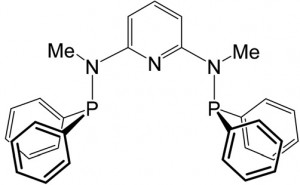Professor Darrin Richeson’s group has carved out an interesting organometallic niche. Their papers feature low-valent metal complexes of pincer ligands combined with detailed computational analysis of the electronic structures. In their recent Dalton Transactions article they report unique coinage metal complexes of the “PN3P” ligand below.
The judicious selection of this particular pincer framework resulted in complexes with geometric properties distinct from those of the same metals with other “PNP”-type ligands. Choosing the ligand with a NR instead of a NH spacer between the pyridine and phosphine moieties enhances the donor strength of the phosphines while rendering the N atoms inert towards deprotonation.
Subtle effects of this adjustment manifest themselves in dramatic changes in the solid-state coordination and geometric properties of their Cu and Ag complexes. Their reported CuBr complex is coordinated by one PN3P ligand and has a distorted trigonal pyramidal geometry. They contrast these to Cu(I) complexes of an analogous PN3P ligand with NH spacers, which coordinate two ligands and in one case displace the halide atom. Using CH2 spacers, a previously reported Cu(I) structure exhibits T-shaped geometry and a non-coordinating triflate anion. The Cu(I) reported here shows a geometry much closer to trigonal pyramidal, with a coordinating triflate anion.
The second part of the paper discusses details of the electronic structure gleaned from DFT calculations. Particularly illuminating is a paragraph on page 19157, summarizing the particulars of the bonding as “a balance of bonding and antibonding interactions…diffuse polarized-π orbitals…(and) back donation.” Perhaps this seems summary seems unsurprising, but there are subtleties in the analysis.
Professor Richeson was my M.Sc. supervisor (I finished in his group six years ago). I write this in gratitude for his mentorship, and in appreciation of his group’s continuing work.
For more details read the full paper:
Coinage metal complexes supported by a “PN3P” scaffold
Gyandshwar Kumar Rao, Serge I. Gorelsky, Ilia Korobkov and Darrin Richeson
Dalton Trans., 2015,44, 19153-19162
DOI: 10.1039/C5DT03515E
 |
Ian Mallov is currently a Ph.D. student in Professor Doug Stephan’s group at the University of Toronto. His research is focused on synthesizing new Lewis-acidic compounds active in Frustrated Lewis Pair chemistry. He grew up in Truro, Nova Scotia and graduated from Dalhousie University and the University of Ottawa, and worked in chemical analysis in industry for three years before returning to grad school. |











